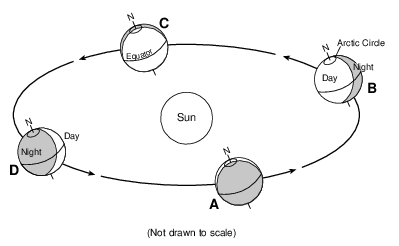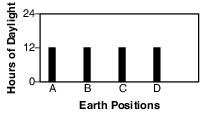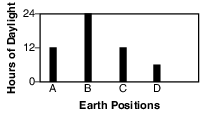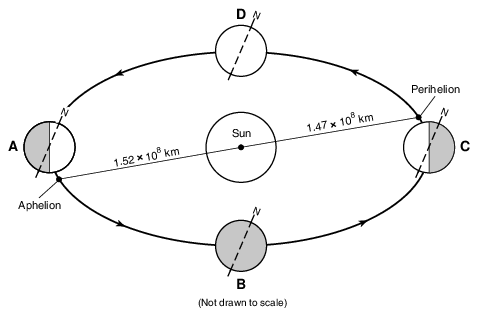Topic: Variations Of Insolation
Variations Of Insolation

Which graph best shows the hours of daylight that occur at the equator on all four Earth positions shown?
(1) 
(2) 
(3) 
(4) 
Cosmic Microwave Background Radiation
In the 1920s, Edwin Hubble’s discovery of a pattern in the red shift of light from galaxies moving away from Earth led to the theory of an expanding universe. This expansion implies that the universe was smaller, denser, and hotter in the past. In the 1940s, scientists predicted that heat (identified as cosmic microwave background radiation) left over from the Big Bang would fill the universe. In the 1960s, satellite probes found that cosmic microwave background radiation fills the universe uniformly in every direction, and indicated a temperature of about 3 kelvins (K). This radiation has been cooling as the universe has been expanding.
The diagram below represents the spectral lines from the light of an element in a laboratory on Earth.

Which diagram below best represents the pattern of spectral lines from the same element when it was observed by Edwin Hubble in the light of one of the distant galaxies?
(1) 
(2) 
(3) 
(4) 

How many hours (h) of daylight are received at the Arctic Circle when Earth is at position A?
(1) 0 h
(2) 12 h
(3) 18 h
(4) 24 h

As the angle of the Sun’s rays striking Earth’s surface at noon changes from 90° to 43°, the length of a shadow cast by an object will
(1) decrease
(2) increase
(3) decrease, then increase
(4) increase, then decrease
An observer in New York City measured the angle of insolation at solar noon each day. During which month did this observer see the noontime angle of insolation increase each day?
(1) April
(2) July
(3) September
(4) December
When equal masses of ice and liquid water receive the same amount of energy, without a change in state, the ice changes temperature faster than the liquid water does because the
(1) specific heat of ice is less than the specific heat of liquid water
(2) specific heat of ice is greater than the specific heat of liquid water
(3) density of ice is less than the density of liquid water
(4) density of ice is greater than the density of liquid water

Which color and texture of Earth materials absorbs the greatest amount of short-wave radiation from the Sun?
(1) light color and smooth texture
(2) light color and rough texture
(3) dark color and smooth texture
(4) dark color and rough texture
What best explains why, in early spring, ice remains longer on Lake Erie than on the surrounding land areas when the air temperature is above freezing?
(1) Water has a higher specific heat than land.
(2) Energy is needed for water to evaporate.
(3) Cool winds from the surrounding land cool the ice on the lake.
(4) Air temperature does not affect water temperature.
An increase in the transparency of Earth’s atmosphere is often caused by
(1) a decrease in cloud cover
(2) a decrease in solar radiation
(3) an increase in airborne dust particles
(4) an increase in the duration of insolation
Most of the electromagnetic energy radiated from Earth’s surface is in the form of
(1) ultraviolet rays
(2) infrared rays
(3) gamma rays
(4) x rays

Write the chemical symbol for the element, shown in the table, that absorbs the two wavelengths of light. [1]
Allow 1 credit for Ca.

The graph in the image provided shows a curve for the changing length of daylight over the course of one year that occurs for an observer at 50° N latitude. On this same graph in the image below, draw a line to show the changing length of daylight over the course of one year that occurs for an observer at 50° S latitude. [1]

Allow 1 credit for any line that extends from the beginning of January to the end of December, and is completely within the clear band shown below.
• Note: It is recommended that an overlay of the same scale as the student answer sheet be used to
• ensure reliability in rating.
• 

State the number of daylight hours at this location on September 23. [1]
h
Allow 1 credit for 12 h.

Explain why the number of daylight hours for all three latitudes was 12 hours on March 21 and September 21. [1]
Allow 1 credit. Acceptable responses include, but are not limited to:
• — These dates represent the first days of spring and fall.
• — The Sun rises due east and sets due west at all latitudes.
• — The Sun’s direct rays are at the equator at solar noon on these dates.
• — March 21 and September 21 are equinoxes.
• — There are 12 hours of daylight and 12 hours of darkness on an equinox at all latitudes.
• — Earth’s axis is not titled toward the Sun or away from the Sun at that time.

State the number of hours of daylight that an observer in New York State will experience when Earth is at position D. [1]
______________ h
Allow 1 credit for 12 h.
